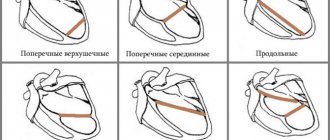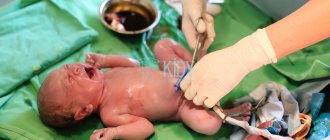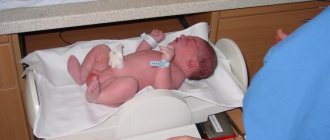What is a heart murmur and how does it happen?
Thanks to the work of the cardiovascular system, tissues and organs receive the necessary nutrients and oxygen.
After birth, a significant restructuring of blood circulation in the pulmonary vessels occurs in the child’s body, the dominant of the right ventricle is replaced by the left, physiological closure of the ductus arteriosus is observed, and the pressure in the pulmonary trunk increases to facilitate the work of the left ventricle. Such changes cause cardiac murmurs. During the examination, the doctor conducts auscultation using a phonendoscope, listening to the heart valves in turn:
- mitral;
- aortic;
- pulmonary valve;
- tricuspid valve.
The auscultation method helps to assess the frequency and rhythm of tones, their melody and timbre.
Causes
The most common sources of heart murmurs in a child are associated with impaired blood flow and the occurrence of turbulence in the supravalvular aorta, pulmonary trunk or organ cavities. The causes of this hemodynamic disorder are a defect in the valve apparatus or septum, vascular aneurysm, decreased blood viscosity due to anemia, and the following cases:
- if the child is premature, the source of the noise is an insufficiently formed heart, incomplete closure of the aortic duct after birth;
- when a soft systolic murmur is heard in the first three days after birth, this indicates anatomical obstruction of the ventricular outlets, which requires daily monitoring over time;
- mixed systolic-diastolic murmur often occurs when the aortic duct is incompletely closed, which closes upon completion of the transition from fetal blood flow after birth;
- the most common cause of heart murmur in a newborn is a patent aortic duct (the turbulence is quiet, blowing, more audible between the second and first heart sounds);
- listening to murmurs in a child during systole is convenient on the third or fourth day in case of cardiomyopathy and impaired transitional circulation, the formation of a pathological shunt from the right side of the heart to the left and vice versa;
- the main sign of pathology of the cardiovascular system and congenital valve defects is hemodynamic disturbances, cyanosis (blue discoloration of the skin), arterial hypoxemia and decreased saturation (oxygen saturation in the blood) less than 75%;
- in older children, the source of noise is a past illness, cold, sore throat or acute respiratory viral infection. As a result, the inflammatory process and bacterial culture provoke damage to the heart valves, endocarditis (inflammation of the endocardium);
- If a child is over five years old and a murmur is heard during auscultation, the cause is often an anomaly of the left ventricle, an accessory chord, which can only be detected by ultrasound of the heart. When there is no hemodynamic disturbance, treatment is not required.
Unlike pathological noise, functional noise is always heard during systole, it is less intense. In newborns, auscultation reveals a greater spread of vortices beyond the boundaries of the heart. If the child does not have a rapid heartbeat, cyanosis or signs of heart failure, then such a noise is not dangerous, but requires observation. It is enough to have an assessment of functional noise over time, recording cardiogram data, and ultrasound of the heart.
Innocent reasons
For example, in newborns this may be an expression of the process of adaptation of blood circulation to life outside the mother’s body. In infants and adolescents with a narrow chest, murmurs are often a consequence of intensive growth of the body, due to which the heart may simply not keep up with the development of other organs. There is an opinion that almost every child, before puberty, has a “noisy” heart at least once. Most often - during or after an illness accompanied by high fever. Or after suffering infections: tonsillitis, scarlet fever, pneumonia. And also with the development of iron deficiency in the body. After all, anemia makes the blood more liquid, and it passes through the heart more easily, causing a specific noise.
Often, functional heart murmurs are associated with congenital anatomical anomalies. Here are the most common ones.
False chords. This is the name given to the extra filaments of connective tissue that arise in the left ventricle and produce a vibrating noise. Very often, although not always, this anomaly goes away with age. However, even if it remains, there is no big problem, because it does not interfere with the blood flow inside the heart, although sometimes it can cause heart rhythm disturbances.
Article on the topic
Surgery in the womb: doctors operated on the heart of an unborn child
Prolapse (bending) of the mitral valve. This anatomical anomaly can already be dangerous. It all depends on the degree of the defect. Significant prolapse is fraught with serious pathology (up to mitral valve insufficiency, when blood flows back into the atrium cavity).
Foramen ovale that did not close in time. This is the name of the hole in the septum of the heart, which connects the right and left atria during the period of intrauterine development of the fetus and normally closes immediately after its birth. But for every second baby up to a year old, or even later, this “window” remains open. It is not closed in 10–25% of adults. And in most cases, this does not lead to anything bad, unless there is a pronounced discharge (mixing of venous and arterial) blood. Therefore, surgery for this reason is very rare, especially in children under 5 years of age.
As a rule, functional heart murmurs go away on their own by adolescence. But just in case, the child’s heart, even with “innocent” noise, must be controlled. Not often - once a year. This is especially true for children with mitral valve prolapse.
Tragedy in the cradle. What can cause sudden infant death?
More details
The Right Action
The basis for the prevention of heart disease in children is compliance with regular medical examinations by a neonatologist and pediatrician according to the following algorithm:
- The primary examination is carried out by a neonatologist in the maternity hospital, when he evaluates cardiac activity using auscultation.
- Screening to diagnose congenital heart defects is done if murmurs are observed in the organ.
- Based on saturation data and ultrasound of the heart, the doctor confirms or removes the diagnosis.
- After discharge from the maternity hospital, the child is supervised at home by a general practitioner for up to a month. Normally, after the third or fourth week, the venous duct closes and the circulatory system begins to fully function. A medical examination helps to identify the slightest deviation from the norm, diagnosing murmurs in newborns.
- Particularly important is the child's infancy (infant up to one year), when the complete restructuring of blood circulation is completed and the doctor makes a conclusion about the nature of the noise.
- Blueness of the skin is the main symptom of hemodynamic disturbances. In combination with severe weakness, dizziness and low hemoglobin - these are indications for examination.
- In addition to auscultation, all children with signs of a heart murmur should be referred for phonocardiography, echocardiography, ultrasound of the heart and great vessels.
- Refusal to examine and treat a child with a heart murmur leads to serious hemodynamic disturbances and heart failure. Regular examinations with a pediatrician help prevent the development of organ pathology.
Heart murmurs in infants: causes and treatment
When the doctor places the phonendoscope against the chest, he hears the heart beating (“knock-knock”), in medicine these sounds are called tones. They occur when the heart valves work. The heart pumps blood, and valves are needed to ensure it flows in the right direction. Before the heart contracts, the valves between the atria and ventricles close. This is necessary in order to release blood from the left ventricle into the aorta (to organs and tissues) and from the right ventricle into the pulmonary artery (to the lungs). When this happens, we hear the first tone (or first “knock”). After the heart contracts, there is a pause (relaxation), at which point the semilunar valves located at the exit from the left ventricle into the aorta, as well as from the right ventricle into the pulmonary artery, close so that the heart can fill with blood. When these valves close, we hear a second tone (second “knock”). These are normal heart sounds. If for any reason an obstacle to smooth, calm blood flow (for example, a narrowing) occurs in the heart or in the region of the heart, a turbulent (vortex) blood flow occurs in this place, and the doctor hears a noise between heart sounds. Heart murmurs can be different: soft, blowing, rough, occurring at the moment of heart relaxation or contraction, etc. - depending on the reasons causing it, and there are many of them. But all noises can be divided into two groups: pathological, which are often the first, and sometimes the only symptom of congenital heart disease in young children, and innocent, which can be heard in absolutely healthy babies. In most cases, an experienced doctor can determine by the nature of the noise whether it is more likely to be pathological or innocent. However, a more accurate answer can only be given by echocardiography (ECHOCG - ultrasound of the heart), in which the doctor sees the structure of the heart and surrounding vessels with his eyes: after all, we are accustomed to trusting them more than our ears. True, these eyes must be experienced, and the apparatus on which the research is performed must be modern. Echocardiography is not mandatory in the first year of a baby’s life. If necessary, the pediatrician will refer you for this examination. In equipped maternity hospitals, in the presence of a heart murmur, echocardiography is performed even on newborn children to exclude congenital heart disease.
Why do heart murmurs occur in infants?
The reasons may vary. Let's look at the main ones. Congenital heart defect. In case of congenital heart disease, saving the child’s life requires constant monitoring by a pediatrician, consultation with a cardiac surgeon, decision on surgical treatment, its timing, and selection of medications if necessary. This is a serious disease, so if the doctor hears a heart murmur in a baby , it is necessary to rule out this pathology. To do this, first of all you need to do an echocardiogram in a specialized institution. If necessary or in doubt, the pediatrician will refer the child for further examination to a cardiac surgery hospital. If there is no such treatment center in the city where the child lives, then you can do research (ECHOCG, ECG, chest x-ray in two projections) and ask the pediatrician to send these documents, accompanied by a detailed statement about the condition and well-being of the baby, for consideration at the cardiac surgery hospital by mail.
Restructuring of blood circulation after birth. Heart murmurs in newborns may be a consequence of changes in the circulatory system after birth. During intrauterine development, the blood in the fetus circulates differently than in a child who has already been born. The fetal lungs do not breathe and cannot enrich the blood with oxygen. The blood receives oxygen through the umbilical cord, from the mother. Therefore, in the fetus, the blood, bypassing the lungs, passes through the so-called ductus arteriosus and the open foramen ovale. The ductus arteriosus connects the pulmonary artery (the vessel leading from the heart to the lungs) and the aorta (the vessel leaving the heart and carrying blood to the organs and tissues of the body). And the open foramen ovale is a hole in the septum between the right and left atria of the heart, from which blood enters the left ventricle and again into the aorta. The fetus needs both a patent foramen ovale and a patent ductus arteriosus. When the baby is born, takes its first breath, the lungs expand, and the umbilical cord is clamped and cut. Now the baby provides itself with oxygen, and blood from the right side of the heart enters the lungs, where it is enriched with oxygen, from the lungs - into the left side of the heart and into the aorta. After birth, the patent ductus arteriosus and patent foramen ovale cease to function and close because they are no longer needed.
Heart murmur: patent ductus arteriosus
The patent ductus arteriosus in healthy full-term newborns ceases to function by the end of 1–2 days, less often during the first week of life. In some cases, this process is delayed. Then the doctor can listen to the baby's heart murmur . As mentioned above, the patent ductus arteriosus connects the aorta and pulmonary artery. The noise occurs due to turbulent blood flow in a narrow duct compared to the aorta and pulmonary artery. In such cases, it is necessary to observe a cardiologist and repeat echocardiography at a frequency determined by the doctor. The presence of a patent ductus arteriosus by 3 months of life is considered a congenital heart defect. However, if its size is small, it can close on its own later, usually up to 1 year. Depending on the condition of the child, the size of the duct and the presence or absence of a tendency to close it, the question of surgical treatment may be raised.
Heart murmur: patent foramen ovale
An open oval window cannot be heard by a doctor using a phonendoscope, since the pressure difference between the atria is small, and a vortex blood flow cannot be created in this place so strong that the doctor can recognize it. In addition, a patent foramen ovale is an opening between the right and left atria that has a valve. This valve prevents blood from flowing from the left atrium to the right. The open foramen ovale continues to function in 50% of children until the age of 1 year; its closure occurs in most cases until the age of 2–3 years. According to statistics, it is detected in 20–25% of adults. The presence of an open oval window does not in any way affect the growth and development of the child, or his health, and is not considered a congenital heart defect, but a minor developmental anomaly. If in the first months of life, according to echocardiography, a child was found to have an open foramen ovale , there is no need to worry, but it is necessary to consult a pediatric cardiologist, repeat echocardiography at 1 year of age and thereafter, if necessary.
However, in most children, heart murmurs are innocent and are associated with the growth characteristics of the chambers and vessels of the heart or with the peculiarities of its structure, for example, with the presence of an additional chord in the cavity of the left ventricle, etc. Let's talk about these noises.
- Heart murmurs associated with uneven growth of the chambers and vessels of the heart . Such noises are normal and physiological, but only an experienced pediatrician can identify them, since they are soft in timbre and quiet, and are heard at certain points above the area of the heart or blood vessels. In themselves, such noises pose absolutely no threat to the development and health of the child and disappear on their own as he grows. However, it is worth recalling that if a pediatrician hears a heart murmur, in any case it is necessary to find out its nature by doing an echocardiogram in a specialized institution in order to exclude anomalies that require treatment.
- Heart murmurs associated with the presence of additional chords (false chords) in the cavity of the left ventricle. These noises are detected quite often and are accompanied by a characteristic noise. Falshchords are fibrous or fibrous-muscular cords (threads) that are located in the left ventricle of the heart, connecting its opposite walls (or muscles called papillary). Due to the fact that the speed of blood movement during contraction of the ventricle is relatively high and the blood “beats” against the chord-string (like a strong wind through wires), a characteristic “squeaking” or “whistling” noise occurs, which the doctor hears. With age, due to the growth of the left ventricular chamber and changes in its shape, the chord can attach to the surface of the heart muscle and, as it were, self-destruct, but this does not always happen. A false chord in the left ventricle is a minor developmental anomaly. There is no need to worry about detecting it in a child, since it does not disrupt the blood flow inside the heart, does not affect its functioning, and does not cause heart failure. The presence of a false chord does not require any restrictions in children (including physical activity). There is a hypothesis that in a small number of patients, false chords may be one of the causes of certain cardiac arrhythmias, but this connection has not yet been proven. When listening to any murmur in the heart, even if it is characteristic of the murmur of an accessory chord in the cavity of the left ventricle, it is necessary to consult a pediatric cardiologist, do an echocardiogram to confirm the diagnosis, and, if necessary, an ECG.
- Heart murmur: diseases not related to the heart itself. Heart murmurs in infants can occur with severe anemia (a group of diseases characterized by a decrease in the content of hemoglobin (a substance in the blood that carries oxygen) in erythrocytes (red blood cells) or the number of red blood cells per unit volume of blood in a person of a given sex and age), if the thyroid function is disrupted glands, rickets, high fever, etc. In this case, the doctor’s task is to identify this pathology, relying on one of its additional symptoms - a heart murmur, to rule out disease of the heart itself and carry out appropriate treatment. Thus, heart murmurs are murmurs that always have a cause related to the structure and size of the heart, its structure and blood circulation inside the heart, its speed and viscosity. In most cases, noises in children are innocent. But we should not forget about such a serious pathology as congenital heart defects, which require immediate action from parents and doctors. To be calm and not worry about the health of the child in the presence of a heart murmur , it is necessary to do echocardiography - a safe and very informative research method.
You might be interested in the article “Does your child have liver problems? Let's diet!" on the website mamaexpert.ru











